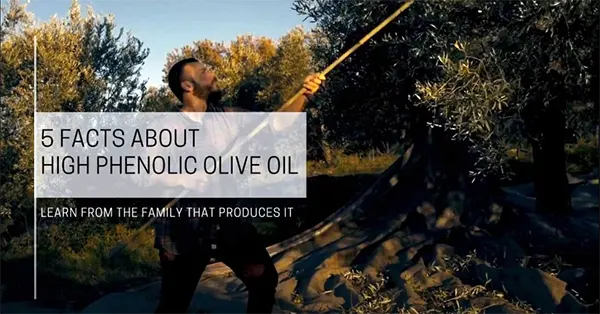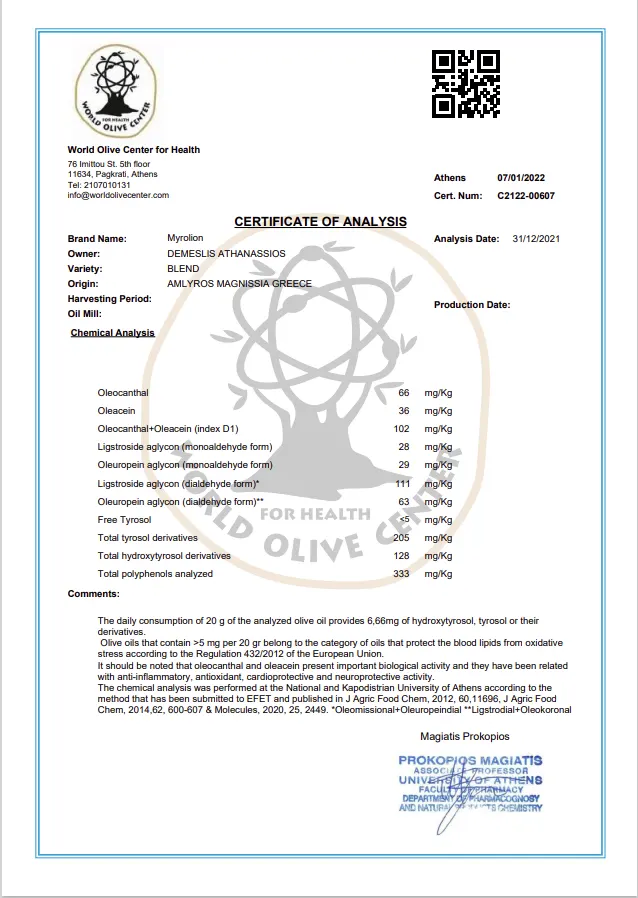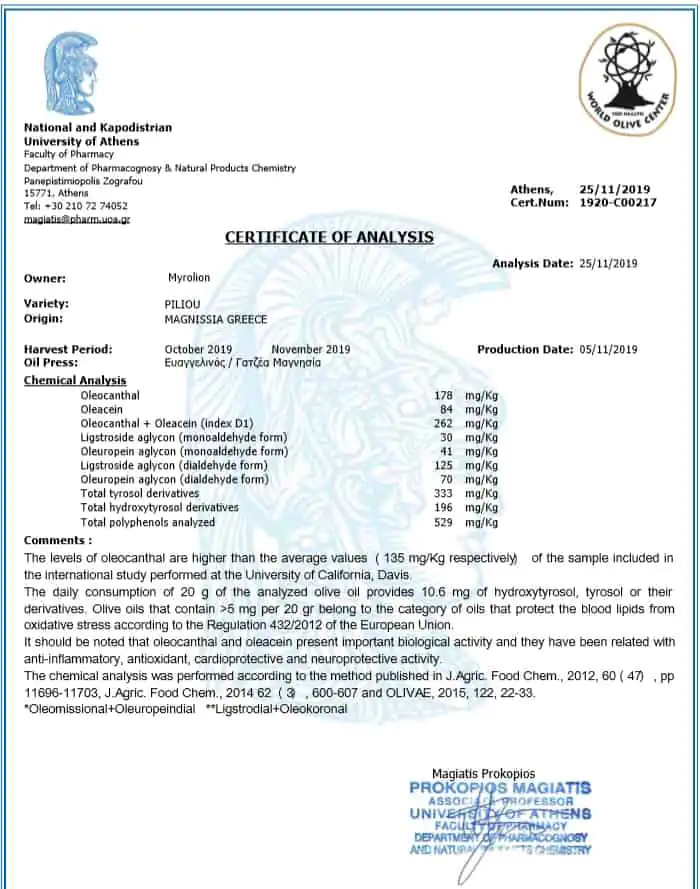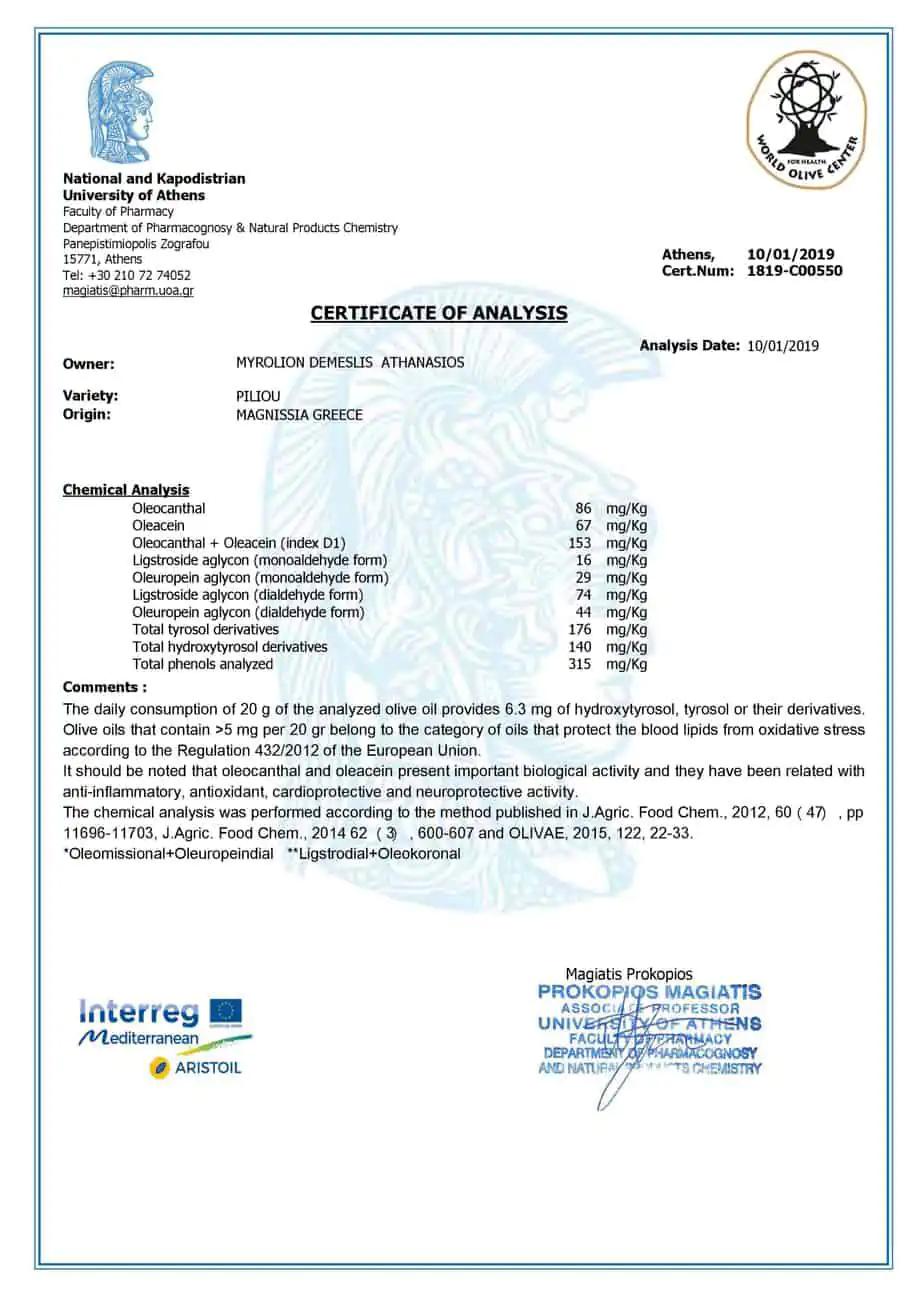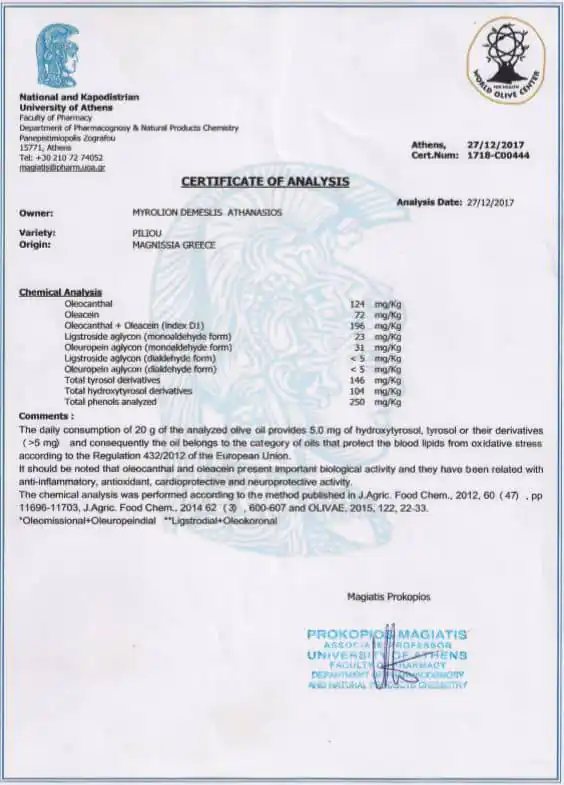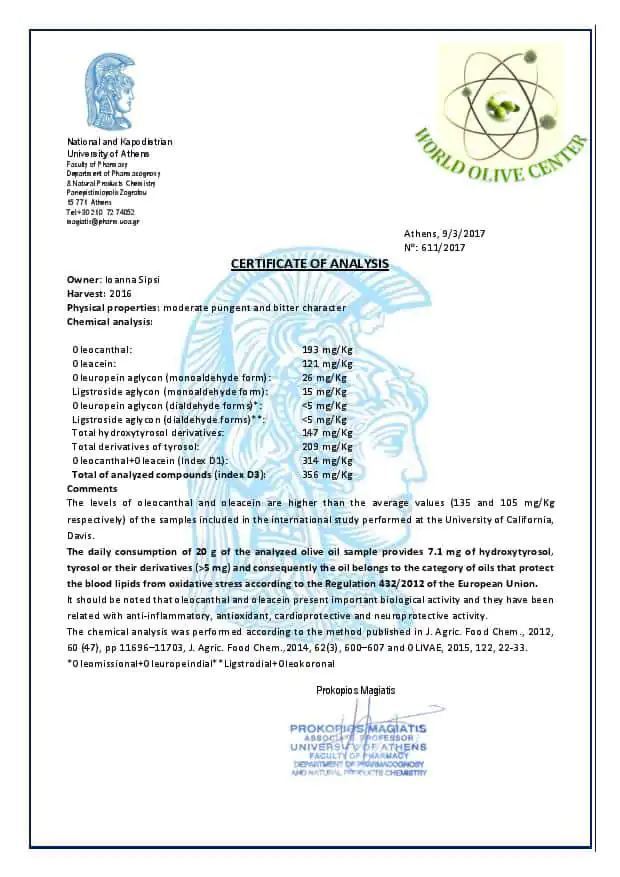High Polyphenol Olive Oil:
What to Know Before Buying
Learn how to identify and most efficiently enjoy polyphenol rich olive oil from the family that produces it.
Enjoy:
– Certified health benefits
– Absence of potentially harmful pesticides
– Optimal value-for-money
– Mouthwatering flavor
Help us:
– Safeguard biodiversity
– Adapt to climate change
– Set a new olive farming paradigm
Written by: Athanasios Demeslis, Producer of Myrolion
Last Update: January 12th 2025
Read Time: 15′
1. What is polyphenol-rich olive oil?
High phenolic is the type of olive oil that contains at least 250 milligrams of polyphenols per kilogram.
2. How much polyphenol-rich olive oil should I consume to receive its health benefits?
20 grams of high phenolic olive oil per day protect blood lipids from oxidative stress, according to EU Regulation 432/2012.
3. What are the health benefits of high polyphenol olive oil?
Besides the official health claim, studies show that olive oil polyphenols benefit our health in many ways.
4. Can I cook with high polyphenol olive oil?
Cooking with high phenolic olive oil provides additional health benefits but it could cause a value-for-money issue.
5. What does polyphenol content depend on? Polyphenol concentration depends on olive cultivar, environmental factors and olive oil production practices.
6. Is it possible to have too much polyphenol-rich olive oil?
Yes, olive oil is a calorically dense food and should be consumed within a specified caloric budget. In addition, long-term consumption of very high concentrations of polyphenols can burden specific organs and tissues. It is important to choose a polyphenol-rich olive oil that matches your needs and goals.
How Does Our Family Keep Myrolion High Phenolic?
1. Amfissa Variety: Myrolion is monovarietal. Our local variety offers high polyphenol concentrations. Also, its olive oil is easy to consume with a delicate and balanced flavour.
2. Diverse Terrain: The intense terrain of our family orchard boosts polyphenol diversity. This makes Myrolion ideal for many health benefits. Also, the high altitude of our orchard helps trees create more polyphenols.
3. Careful Extraction: We extract Myrolion below 27°C . Malaxation takes 30′-45′ to protect olive oil nutrients and antioxidants. We know the secrets to deliver a top-notch product.
4. Meticulous Olive Oil Storage: We store Myrolion in ideal conditions. Once you order, we send it directly from our warehouse.
What are Phenols?
The fruit of olea europaea contains chemical compounds called phenols or phenolic compounds.
There is enormous variation among phenolic compounds that you may find in a wide range of foods. Yet, different types of polyphenols have different impact on human health.
In olive oil with high phenolic content and some types of table olives we can find unique polyphenols that have a plethora of health benefits.
Which Polyphenols are Unique to Olive Oil?
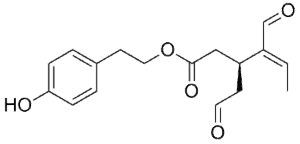
Oleocanthal
It is a natural phenolic compound found only in the olive fruit – hence the prefix “oleo”. It seems to cause the pungent sensation in olive oil’s flavor. It is a tyrosol ester.

Tyrosol
Tyrosol is a natural antioxidant that you may find in numerous sources, such as argan oil, although it is mainly found in EVOO.
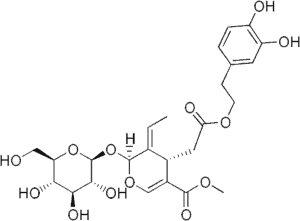
Oleuropein
Oleuropein is a natural phenolic compound found in olive leaves and green olives, mainly in olives’ skin and flesh. It causes the bitter taste in EVOO.

Oleacein
You can find this natural phenolic compound both in olive oil and the royal jasmine. It is among the most abundant phenolic compounds in EVOO.
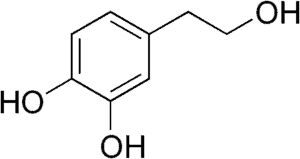
Hydroxytyrosol
It thrives in olives, olive pulp, olive leaves and in lesser amounts in olive oil. It is a colorless, odorless liquid.

Ligstroside
It belongs to the class of organic compounds known as phenolic glycosides. The phenolic structure attaches to a glycosyl moiety. Ligstroside is found in olive fruit and in smaller amounts in other fruit.
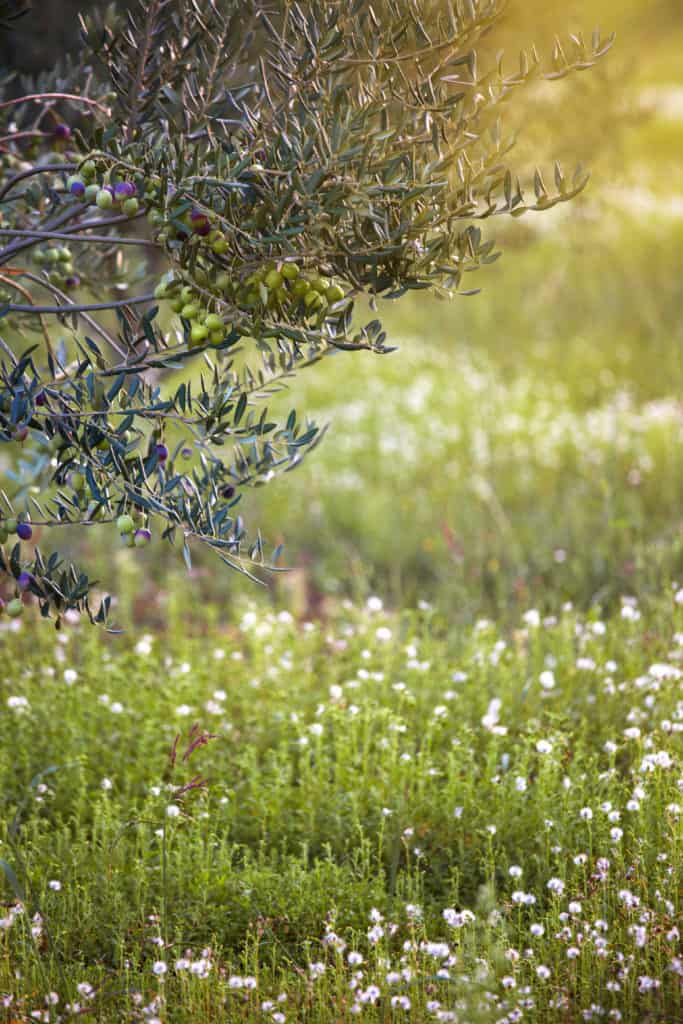
What are the Health Benefits of Polyphenol Rich Olive Oil?
We clarify that studies on olive oil polyphenols suggest potential health benefits in the context of a balanced lifestyle. High phenolic olive oil is not an elixir, but a healthy, natural food.
Health Benefits of Oleocanthal
- Oleocanthal acts as an anti-inflammatory agent and also has anti-oxidant properties.
- High oleocanthal olive oil causes a rupture of cancerous cells. It releases enzymes that cause cell death, without harming healthy cells.
- Also, oleocanthal enhances a potential neuroprotective mechanism against Alzheimer’s Disease.
- A study published in October 2020 showed that oleocanthal-rich olive oil helps facilitate weight loss and battles chronic disease. Specifically, 23 patients suffering from the metabolic syndrome and hepatic steatosis were treated with high oleocanthal extra virgin olive oil for two months. Ingestion of EVOO with a high oleocanthal concentration had beneficial effects on various metabolic parameters, inflammation and abdominal fat distribution. This is an important finding for a category of patients that has a high cardiometabolic risk.
Health Benefits of Oleuropein
- Oleuropein health benefits include anti-oxidant activity,
- Natural anti-inflammatory activity,
- Low blood glucose values,
- Free radicals removal,
- has cardioprotective and neuroprotective activity, providing protection against heart disease,
- modulates gut microbiota, specifically Coriobacteriaceae and Lactobacillaceae in the large intestine,
- mitigates muscle aging
Health Benefits of Oleacein
Oleacein is one of the most abundant polyphenols in extra virgin olive oil . This phenolic compound has
- antioxidant,
- anti-inflammatory,
- anti-proliferative,
- antimicrobial activity,
- it seems to decrease the progression of atherosclerosis.
- A new clinical trial about chronic lymphocytic leukemia provided more insight. Olive oil with a high oleocanthal and oleacein content decreased cancerous white blood cells. It also caused an increase in the specialized death of cancer cells. Nine out of ten patients experienced these results.
Additional Health Benefits
– A study published in January 13th 2022, studied the mechanism through which olive oil polyphenols, and especially hydroxytyrosol, preserve brain health and provide new ways to promote anti-aging and protection against cognitive disorders.
– Olive oil polyphenols display important beneficial properties against atherosclerosis and Cardiovascular Disease (CVD).
– In a clinical trial published on November 10th 2020 in the Journal of Alzheimer’s Disease, it was seen that polyphenol rich olive oil and moderate polyphenol olive oil improve mild cognitive impairment. It was surprising to see that patients who consumed either type of EVOO performed better than participants who only followed the Mediterranean Diet, with simply extra virgin olive oil.
– In a recent study on the effects of natural foods on treatment of COVID-19, hydroxytyrosol has been described as “a natural molecule of potential interest in treating COVID-19, reducing the oxidative and inflammatory response, and it may be a good adjuvant therapy in combination with other treatments, such as antivirals.” This is not a statement that olive oil treats this viral disease. It only suggests that hydroxytyrosol plays a supportive role for the immune system.
– A study that was published on February 03, 2021 found that high polyphenol olive oil may lower the risk of vascular disease associated with type 2 diabetes. While similar results have been reported in previous studies, this trial revealed that the type of olive oil is an important variable. Specifically, a single dosage of 50ml of high polyphenol EVOO improved the ability of blood vessels to expand when blood flows through them. This indicates that polyphenol-rich olive oil could be a suitable food for adults who are in risk of type 2 diabetes. It is important to note that the endothelial function was not improved by consuming refined olive oil. According to the researchers, the health benefits derive from the polyphenol concentration and diversity in specific olive oils, which result to anti-inflammatory and anti-oxidation properties.
– Of course, olive oil’s health benefits are not restricted to phenolic compounds. For example, Elenolide is a non-phenolic compound of olive oil related to oleuropein or ligstroside. It has activity against high blood pressure.
In a nutshell, high phenolic olive oil is full of health protecting compounds. Such health benefits are not general to olive oil. For example, refined olive oil has a very small polyphenol concentration.
What Affects the Phenolic Content in Olive Oil?
Our family has been a proud member of the first large-scale research program, Aristoil. It helped researchers and producers to reveal polyphenol mechanics. As a result, we know first hand what affects phenolic content.
So, what should you keep an eye on when looking for a long term high phenolic olive oil producer to supply your family?
- Higher altitude olive orchards tend to produce higher quantities of phenolic compounds. Our family’s trees can be found all the way from next to the sea to over 350 meters high. Myrolion High Polyphenol Olive Oil is extracted from olives that have been harvested from our mountainous groves. We use the sea-shore groves for table olives and camping!
- Less water intake causes olive trees to produce higher concentrations of polyphenols. Make sure your producer is aware of the ideal watering practices. In Myrolion, we don’t use irrigations or watering of any kind. Thankfully, for now, rainfall in our area is great for keeping the trees healthy and rich in polyphenols.
- Olive pressing is a crucial process that affects for polyphenols. Temperature, duration, oxygen presence and water presence are all important factors that can greatly affect high polyphenol content. Athanasios knows all the secrets and is passionate about learning the new details that research brings out. You are in safe hands.
Which Olive Oils Have the Highest Polyphenols?
Olive varieties like Coratina and Koroneiki yield higher polyphenol content because of their genes. But there are so many factors that impact olive oil polyphenols. As a result, it would not be the most efficient way to select your olive oil based on olive variety alone.
How is High Polyphenol Olive Oil Certified?
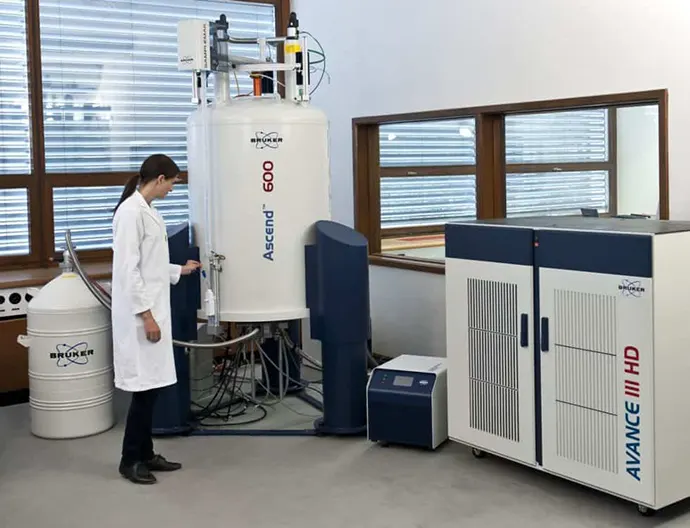
Does Greek Olive Oil Have the Highest Phenolic Content?
It is common that Greek olive oil brands bear a health claim related to olive oil polyphenols. Does that mean that EVOOs from other countries are not as rich in phenols? No.
The reason for this is that a great deal of the research on olive oil polyphenols has been carried out in Greece, specifically in the University of Athens.
As a result, olive oil producers from Greece have been more in touch with the phenolic profile of olive oil and have worked in a more dedicated manner on extracting olive oil with high phenolic content.
Does Phenolic Content Affect Olive Oil Flavor?
Yes. The more polyphenols an olive oil has the more intense its sensory profile in general. Some polyphenols have been also linked to specific sensory features; for example oleuropein is responsible for the bitter sensation at the back of your tongue, while oleocanthal and oleacein seem to bring the peppery, pungent feeling to your mouth.
But this is not necessarily the whole case. Different individuals have different sensitivity to bitterness and pungency. Also, each tasting experience is different, given the physical and emotional context. For example, the less calm and focused you are, the less able you are to identify specific sensory features.
As a result, we cannot use EVOO’s flavor as a way to quantify its phenolic content. The factors that affect a tasting experience are just too many.
Is There Such a Thing as Too Much High Polyphenol EVOO?
There is great variation in polyphenol concentrations even within the high phenolic spectrum. It varies all the way from 250mg/kg to over 3000mg/kg. There are even cultivars that need additional steps during extraction to lower the polyphenol concentration, as it affects olive oil flavor negatively, to the point it can be graded as “unbalanced” and lose its Extra Virginity.
Truth is that antioxidants can have the opposite effects in very high quantities, although such quantities are usually found in targeted supplements.

Dr. Emma Beckett
Molecular Nutritionist, University of Newcastle
“More is not always more in nutrition. And too much can be a bad thing, especially in the mega high doses coming in the supplements.”
At this point, we don’t have enough data to support that “the more, the better.” Specifically, we don’t know the point after which the high concentration can be more of a burden than a benefit. However, in various studies beneficial effects have been observed anywhere from 250mg/kg to over 1000mg/kg.
A recent study revealed that olive oil with a high phenolic content of 800 mg/kg or more can have detrimental effects on specific tissues, including the spleen, pancreas, liver, and heart, where it induced oxidative stress and impaired antioxidant defense mechanisms.
My personal opinion as a producer and consumer of polyphenol-rich olive oil is to aim for olive oils with phenolic content up to around 700–750 mg/kg for long-term preventative benefits as part of a healthy diet and lifestyle. Opt for olive oils with very high phenolic content (over 800 mg/kg) only in cases of health crises, where their potent antioxidant properties may serve as an additional ally in your recovery journey. Please note that I am not a certified nutritionist or medical doctor, and this perspective is based on my experience and understanding as an olive oil producer.
We suggest you stick to official guidelines and make sure to do your research. There is no miracle food, only a balanced lifestyle and diet.
How is the Term “High Polyphenol” Related to “Extra Virgin”, “Cold Pressed” and “Organic”?
Polyphenol Rich & Extra Virgin:
It is possible for Extra Virgin olive oil to not be High Phenolic and vice versa.
For example, it is possible for an olive oil to be within the extra virgin chemical spectrum and in the same time be fruity, pungent and bitter enough to meet the sensory standards, while having a polyphenol concentration of 150mg/kg.
Also, it is possible for an olive oil to have a high phenolic content but also have sensory defects due to bad practices.
Polyphenol Rich & Cold Pressed:
Think of Cold Pressed as “how” and High Phenolic as “what”. When olive oil is cold pressed, meaning it has been extracted below 27 degrees Celsius, then chances are it will be within the High Phenolic spectrum, since more polyphenols will have been preserved. Although this is not definite either. Don’t expect to get a significant intake of polyphenols from refined oil, pomace oil, or even virgin oil.
Polyphenol Rich & Organic:
It is possible for High Phenolic EVOO to be either organic or non-organic. These terms are not directly related to each other.
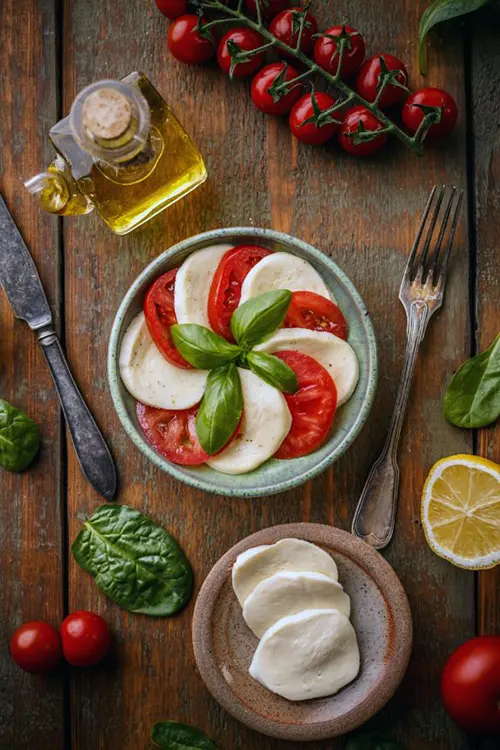
How to Use Polyphenol Rich Olive Oil in Your Meals?
Olive oil consumption in the Mediterranean basin is very high. Olive oil is the basic fat of the Mediterranean diet because it is practical. Besides the overall nutritional benefit, you can drizzle it as salad dressing along with other condiments such as balsamic vinegar. You can using for dipping or for frying eggs, fish, etc. However cooking oil is not the same as olive oil for raw use.
The reason high phenolic olive oil is extracted in low temperatures is that phenolic compounds and other volatile chemical compounds that add to the flavor are sensitive to high temperatures.
The same goes for cooking temperatures. Oleocanthal, oleuropein, oleacein and other phenols are lost when olive oil is heated. Fatty acids, like oleic acid which is olive oil’s most abundant monounsaturated fat, maintain their consistency at higher temperatures.
Does that mean that there is no point cooking with olive oil? Absolutely not. A study showed that cooking with olive oil is the best choice! After all, a study on the effect of sautéing on olive oil polyphenols showed that enough polyphenols survive cooking to provide their unique health benefits
However, there is a value-for-money issue here. While not all polyphenols are lost upon heating, most of them are. Cooking with olive oil is healthy, in part because some of the polyphenols that are not lost add to the overall nutritional value of the meal. But ultimately, you don’t get all the value you paid for unless you use the olive oil raw, in dressings, salads, etc.
We believe that it comes down to income. If you can afford to devote a good deal of your budget to excellent nutrition, then it makes sense to cook with high phenolic olive oil. If your budget is not as high, then you might consider purchasing high phenolic olive oil for raw use, and some non high phenolic olive oil for cooking, but always make sure you use organic olive oil. See more details on our olive oil facts page.
How to Use Polyphenol Rich Olive Oil on the Skin?
Olive oil’s benefits on the skin are quite popuplar for a long time. Vitamins A, D, E, and K are beneficial to the skin, while being an easy way to moisturize the skin and hair.
According to a patent regarding treatment of skin damage using olive oil polyphenols, olive oil polyphenols can be topically applied to treat skin damage, such as contact dermatitis, particularly diaper area dermatitis, atopic dermatitis, xerosis, eczema including severe hand and foot eczema, rosacea, seborrhea, psoriasis, thermal and radiation burns, other types of skin inflammation and aging.
How to Preserve High Polyphenol Olive Oil
To preserve the phenolic content of olive oil you need to simply follow the general guidelines for olive oil storage.
- Use a glass bottle or a bag-in-box container. A 2020 study on the best olive oil storage methods found that glass bottles and bag-in-box containers are most efficient.
- If you plan to use the oil long after the harvest date make sure to choose a filtered olive oil. Unfiltered olive oil goes bad way faster. Small pulp and water particles can breach the chemical structure of olive oil, leading to a fast degradation. This will result in an intense rancid organoleptic feature.
- Keep the olive oil bottle away from high temperatures. Ideally, you want to keep it below 18°C (64.5°F). A cellar or light refrigeration will do.
- Keep it away from light, oxygen and humidity. The various phytonutrients, like monounsaturated fatty acids, can break down to free fatty acids. Phenolic compounds can break down to other phenolic or non-phenolic compounds that don’t play an active health promoting role.
How Long Does Olive Oil Retain High Polyphenol Content After Bottling?
It depends on:
- the polyphenol content the olive oil starts with
- the way you store it
If you choose an olive oil with a polyphenol content around 500 mg/kg, like Myrolion, and if you follow the storage instructions described above, then you can be confident that the olive oil will maintain its high phenolic content for at least a year.
Olive oil’s polyphenol content depends on numerous factors that are related to climate, genetics, cultivation, harvesting, pressing and storing. The certifications below prove that we are doing all there is to create tasty, healthy, safe olive oil for your and your family. If you have more questions, feel free to contact us for all the details!

